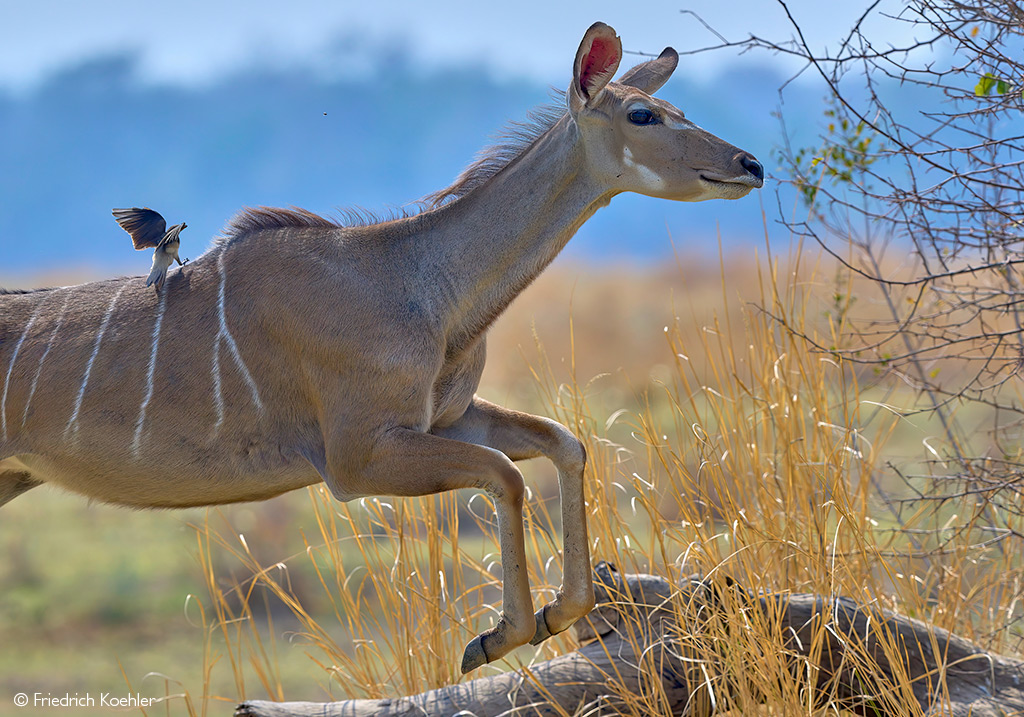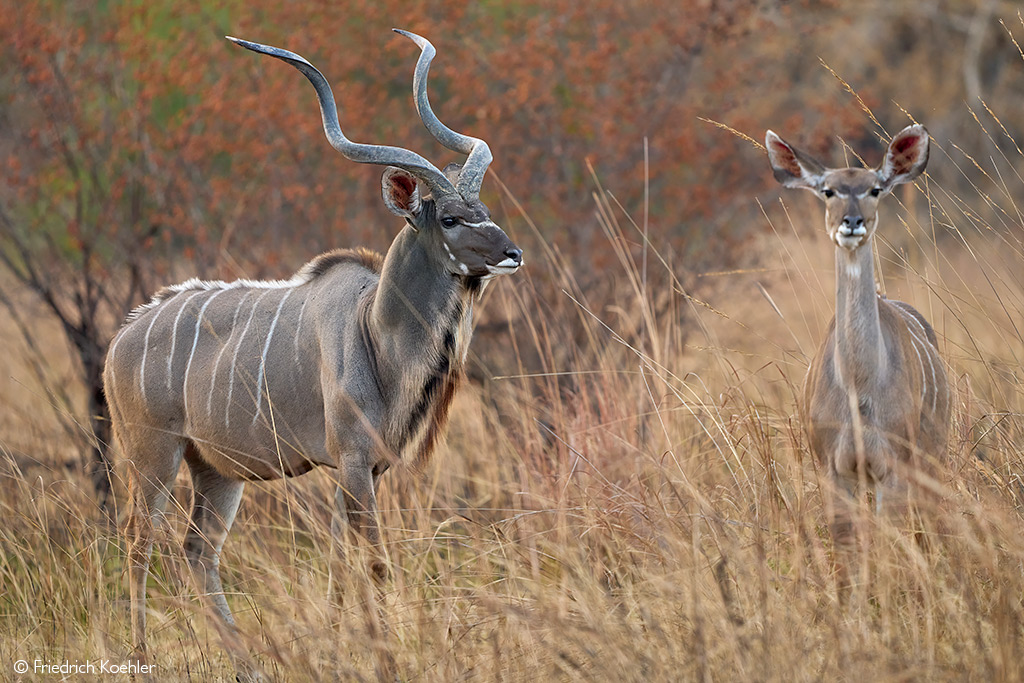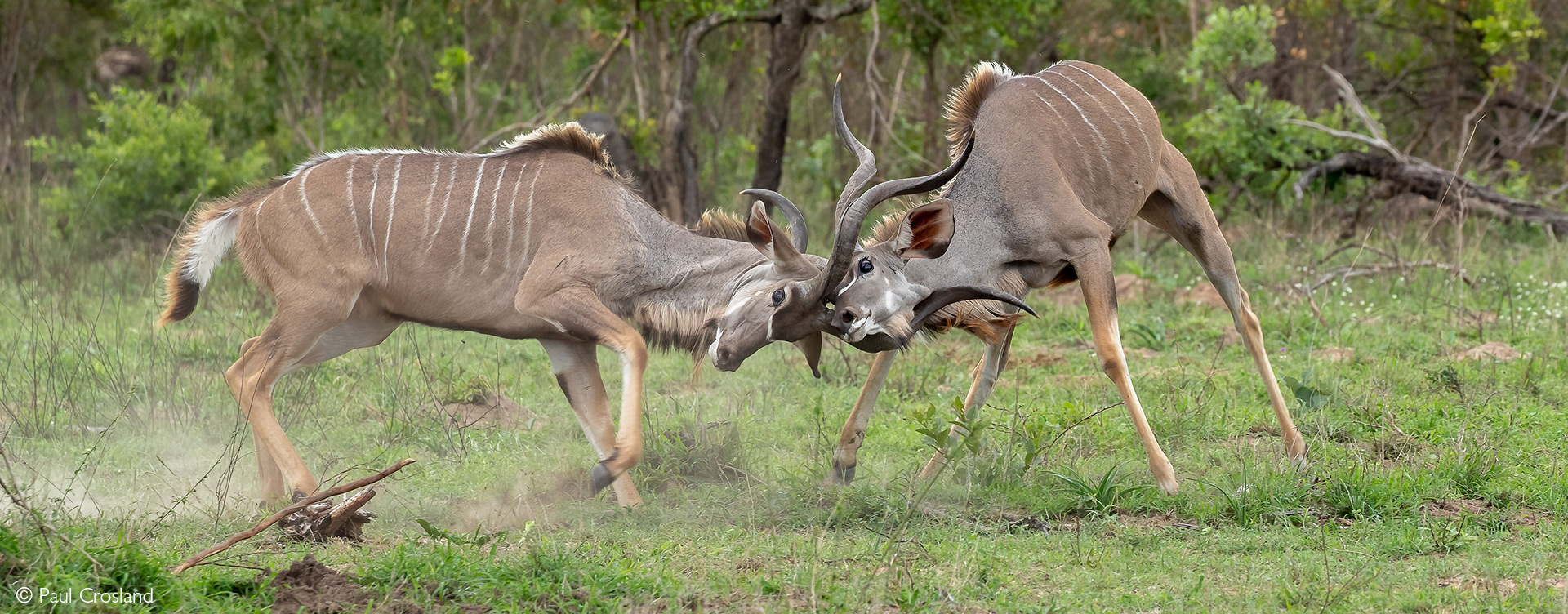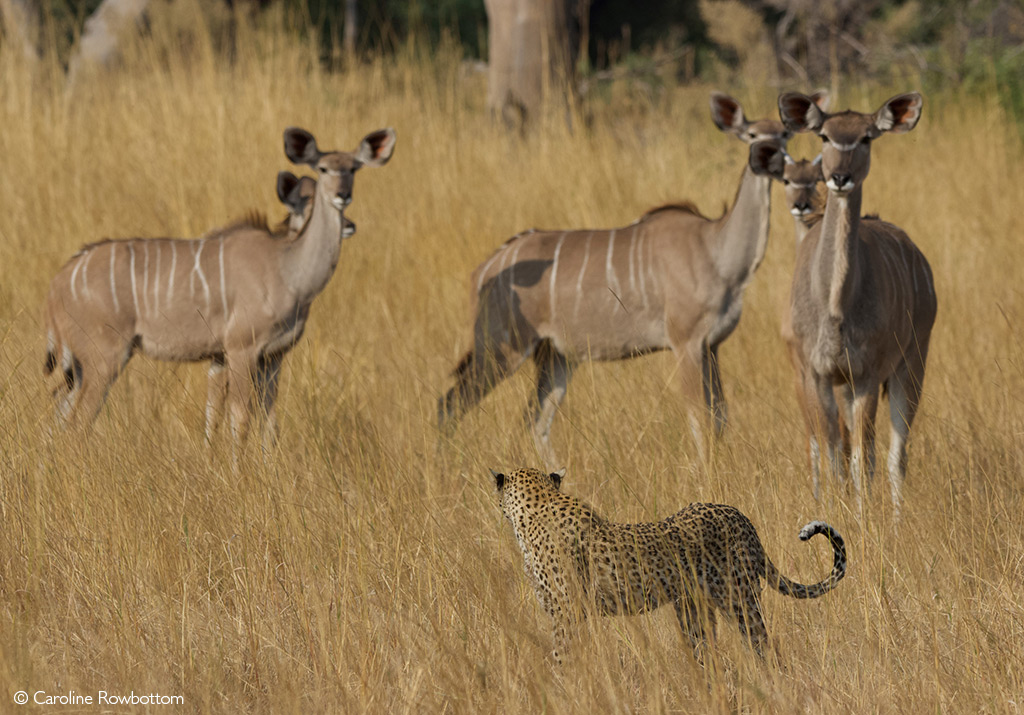
Doe-eyed grace and elegance


If cliches are to be believed, then beauty is in the eye of the beholder – a subjective standard upon which there can be no universal agreement. Yet of Africa’s over 70 antelope species, there can be no question that some are more bewitching than others. There are the stately eland and the glamorous sable, the burnished nyala and the beguiling impala. And then there is the kudu, the doe-eyed epitome of grace and elegance, all slender legs and eyes and a magnificent set of horns.
There are no beauty competitions in the wilderness (thank goodness), but if there were, the kudu would unequivocally be a shoo-in for one of the top spots.

All about the kudus (kudos?)
There are two species of kudu – the greater kudu (Tragelaphus strepsiceros) and the lesser kudu (Tragelaphus imberbis). Though humans could probably have done a better job with the common names (“lesser” is a bit pejorative, is it not?), the monikers accurately capture the size difference between the two. The greater kudu – an icon of the African safari – is substantially taller and heavier than its comparatively petite cousin. Lesser kudu also have a smaller distribution and are found only in East Africa, with a preference for semi-arid habitats. Greater kudu occur more widely across much of the continent, including most of southern and East Africa and just south of the Sahel in Central Africa.
Size aside, the morphological differences between the two species are subtle. The males are similarly equipped with an impressive pair of spiralling horns (more on these below), and sexual dimorphism is pronounced. Both species are decorated with a strip of white on the back, which bleeds into a delicate pattern of stripes running down the flank like dripping paint. White chevrons run from the inside of the eyes, contrasting against the rufous coat. Male greater kudu have a well-developed ridge of hair that runs down the length of the neck like an upside-down mohawk. This feature is absent in the lesser kudu, which instead has a striking set of black and white bands.
Both species are cryptic antelope with a preference for dense vegetation. They are not fast and rely instead on their agility and spectacular jumping prowess to escape potential predators, jinking and jiving through the trees when pursued. Kudu are relatively strict browsers (though greater kudu have been observed grazing) and can survive for long periods without drinking, supplementing their water intake with succulents and fruits.


Quick facts about the kudu
| Greater kudu | Lesser kudu | |
| Av. Height (shoulder) | M: 135-160cm F: 121 cm |
M: 95-105 cm F: 90-100 cm |
| Av. Mass | M: 190-270kg F: 120-210 kg |
M: 90-108 kg F: 56-70 kg |
| Gestation period | 240 days (8 months) | Between 7 and 8 months |
| IUCN Red List | Least Concern | Near Threatened |
To a greater or lesser extent
It is no secret that our understanding of antelope phylogeny is not dissimilar to a tangled ball of wool at present – based on physical similarities and occasionally inaccurate assumptions. Scientists are using genetic tools to disentangle the mess and have made considerable strides towards understanding evolutionary relationships. However, a great deal of work is still to be done. Kudu belong to the Tragelaphini – the spiral-horned antelope tribe, which includes nine different species in two genera (for now). Thus, they are related to eland, nyala, bushbuck, sitatunga and the bongo. The closest relatives to this tribe are bovines, such as buffalos, bison, and wild cattle.
The natural assumption would be that the greater and lesser kudu would be more closely related to each other than any other member of the Tragelaphini tribe, but, fascinatingly, this does not seem to be the case. A comprehensive analysis conducted in 2005 of mitochondrial DNA suggested that the lesser kudu is the basal member of the tribe. Even more confusingly, later research on nuclear DNA indicated that lesser kudu and nyala separated from the rest of the Tragelaphini at least 13 million years ago. Either way that means that, bizarrely, the lesser kudu is more closely related to the nyala, and the greater kudu is more closely related to the mountain nyala. The distance between the lesser kudu and the rest of the Tragelaphini tribe has even prompted some scientists to argue that it represents an entirely different genus – the Ammelaphus.
As if the hairs could not be split any finer, next comes the subspecies question. There are currently three commonly accepted subspecies of greater kudu:
- s. strepsiceros – occurs over much of southern Africa
- s. chora – found in northeastern Africa, in northern Kenya, Ethiopia, Somalia, Eritrea and eastern Sudan
- s. cottoni – found in scattered populations in Chad and western Sudan
None of these subspecies has yet been recognised on the IUCN Red List. Some biologists have even proposed splitting the greater kudu into four different species (!) based on genetic evidence and morphological differences. But we may have to cross that bridge when it becomes more widely accepted…


Spiralling out
At this juncture, moving swiftly along from the minutiae of kudu taxonomy to some of their more apparent features seems appropriate. Naturally, the impressive spiral horns of the bulls tend to leave a lasting impression on first-time visitors to Africa, making them a delightful spot on any safari. (Check out these safaris where you can spot kudu and more). In greater kudu, these bony protuberances can achieve two and a half or even three full twists and, if straightened, would reach over a metre in length. Record-breaking specimens have been measured at over 180cm.

The bulls use these horns primarily as an intimidation tactic. Kudu are gregarious and not territorial, but competition may arise over a female in oestrus (receptive to mating). However, actual physical confrontations are rare, and the larger, more dominant bull usually frightens away potential competitors by displaying his full size. Evenly matched contenders may clash horns, sometimes with fatal consequences. Though such reports are sporadic, kudu bulls have been known to tangle their twisting horns so severely that they find themselves locked together and may eventually die of dehydration, a broken neck or predation.
Like the stag of Aesop’s Fables, these magnificent horns have disadvantages, especially for an animal that usually runs through dense vegetation to escape predators. When fleeing, the bulls occasionally stretch their heads forward and tilt the horns flat along their necks, making navigation challenging. (There is a common old guide’s tale that they can roll their eyes back and look back at the pursuing predator through the hollow horn – it should not need to be clarified that this is physically impossible. The horn is solid bone.) It does not, however, seem to hinder them unduly!


The sense and sensibility of the kudu
The enormous satellite-dish ears of the kudu are another notable feature contributing to their other-worldly, innocent beauty. Fairly obviously, these exaggerated auricles are essential in catching and amplifying sound waves, conferring an exceptional sense of hearing. The kudu’s excellent aural faculties and equally acute eyesight make them one of the more reliable sentinels in the bushveld. When a kudu spots a potential predator, it lets loose an astonishingly loud alarm bark that can travel several kilometres on a cold morning. Many a desperate guide following this booming sound has found themselves well rewarded with a leopard or lion sighting courtesy of a vigilant kudu.

Even without the bonus of a big cat, any aesthete should appreciate the opportunity to feast their eyes upon the picture of natural perfection that is the kudu. They are shy animals and not always confiding around vehicles full of loud, gawking onlookers, but most will allow for a brief sighting if approached carefully. Kudu-seekers will generally find greater kudus without difficulty on most popular safari tracks. Lesser kudus can be a bit more tricky, but the arid areas of southern Kenya and northern Tanzania are an excellent place to start.
Want to see greater and lesser kudu in the wild? Get in touch with our travel team to discuss your kudu-seeking safari – details below this story.
To comment on this story: Login (or sign up) to our app here - it's a troll-free safe place 🙂.![]()






